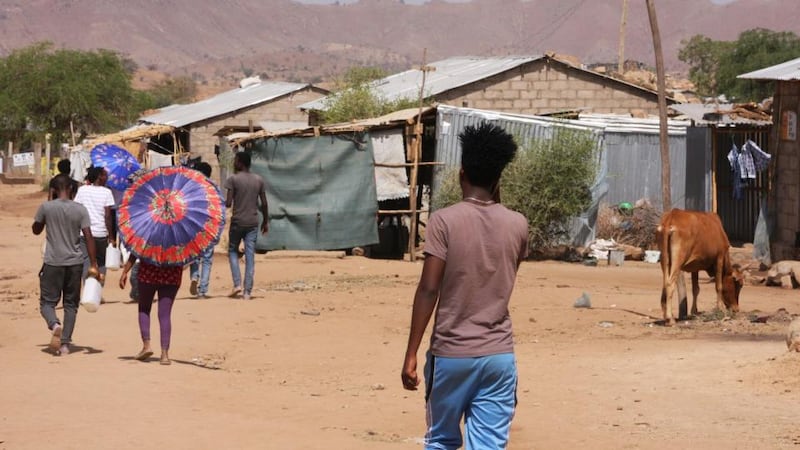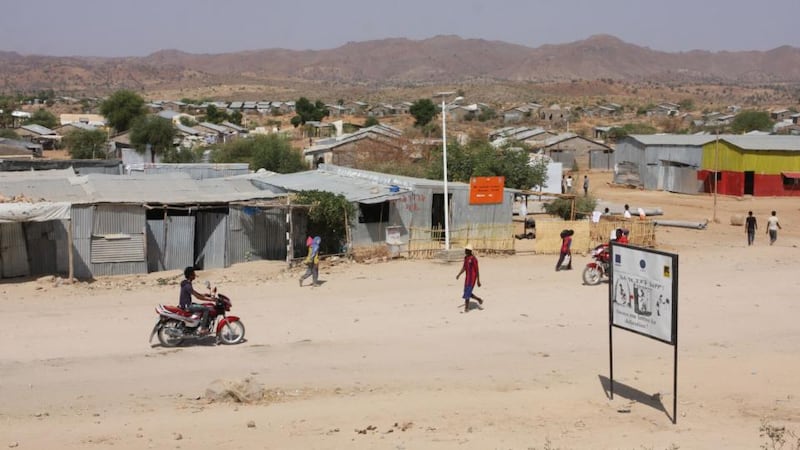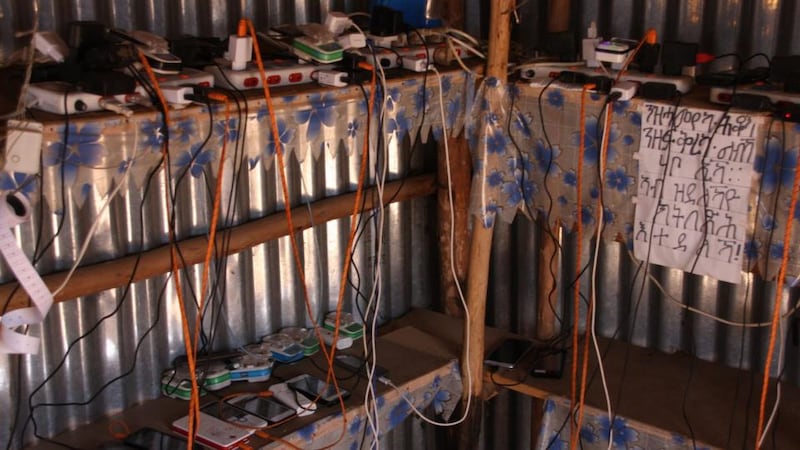Each night along the border of arid hills, Eritreans cautiously move through the terrain's dead ground out of sight of their own military to escape into Ethiopia's northernmost Tigray region.
“After we crossed we tried to sleep in the desert until daybreak, but we could hear hyenas around us,” said 22-year-old Yordanos, who crossed with her two children and another mother with her two children. “We started shouting and then the Ethiopian soldiers came – they were like brothers to us.”
Ethiopia and Eritrea loathe each other at a political level, and yet Ethiopia is embracing the burden of endlessly arriving Eritrean refugees along the shared 565-mile border – many of whom remain in Ethiopia for years that turn into decades.
Why such magnanimity to one’s implacable foe, and from a government roundly criticised for its human rights record and brutal treatment of its own citizenry during recent protests?
“We differentiate between the government and its people,” said Estifanos Gebremedhin, of Ethiopia’s refugee agency, the Administration for Refugee and Returnee Affairs (Arra). “We are the same people, we share the same blood, even the same grandfathers.”
Eritrea used to be Ethiopia’s most northern region before a referendum officially giving it independence in 1993 meant Tigray became the most northern.
Hence on both sides of the border, many people share the same language – Tigrinya – as well as Orthodox religion and cultural traditions.
Detention and torture
“Most say they faced military conscription, religious persecution, arbitrary detention, torture,” said Teshome Kasa, co-ordinator of the refugee screening centre in the Tigray town of Endabaguna, where refugees such as Yordanos are taken after being found. “Land division by the government is a new complaint.”

At the same time as the apparent comradeship offered by Ethiopia, it helps that the likes of UK and Europe are increasingly providing Ethiopia with financial incentives to keep refugees within its borders – similar to the approach taken with Turkey – so Eritreans don't move onwards.
Between 40,000 and 47,000 Eritreans applied for asylum in Europe each year from 2014 to 2016, according to Eurostat, the statistical office of the European Union.
A UN report released last year accused Eritrea’s leadership of crimes against humanity. Eritrea has been called one of the world’s fastest-emptying nations.
There are, however, others who argue that there is a lack of nuance applied to the situation in Eritrea.
"Things aren't as bad as the [UN]report claims," Bronwyn Bruton, deputy director of the Africa Centre of the Atlantic Council in Washington, wrote in a New York Times opinion article last year, highlighting how Eritrea's levels of education and healthcare are relatively impressive for such a poor country. "[The report] entrenches the skewed perspective long dominant in policy circles and the media in the West."
Refugees, however, typically tell a different story. “Nothing is exaggerated,” said Dawit, an Eritrean refugee living for eight years in Shimelba camp, the first of four camps now dedicated to housing Eritrean refugees in Tigray. “We have the victims of rape, torture and imprisonment in our camp who can testify.”
Limited access
Verifying the claims and counterclaims is hampered by access to Eritrea remaining so limited to foreigners – especially journalists. But what appears beyond question is that Eritreans are coming to Ethiopia in droves. In February 2017 alone, for example, 3,367 Eritrean refugees arrived in Ethiopia, according to Arra.
About 165,000 Eritrean refugees and asylum seekers currently reside in Ethiopia, according to the UN.
Ethiopia’s open-door policy is in marked contrast to the strategies of reducing and preventing migrant flows that are being adopted in many western societies.
"Ethiopia strongly believes that generous hosting of refugees will be good for regional relationships down the road," said Jennifer Riggan, an associate professor of International Studies at Arcadia University in the US, and analyst of Eritrean refugees in Ethiopia.
Having been opened by the UN refugee agency, the UNHCR, in 2013, Hitsats is the newest of the four camps and houses 11,000, of whom about 80 per cent are under 35.
Camp co-ordinator Haftam Telemickael takes issue with debate in the West about whether refugees are political or economic migrants. “Even if they are seeking political asylum, there will be an economic side to it as they are young and need to generate income to live their lives,” he said.

Outside his office, a group of refugees are meeting a camp staff member to change their ration cards. Each month a person is entitled to 10kg of wheat, 1kg of palm oil, 1kg of protein powder, a quarter kilogramme of salt and sugar each, one piece of soap, and 60 Ethiopian birr (€2.25) spending money.
Simmering frictions
"In Sudan there are more problems, we can sleep peacefully here," said 32-year-old Ariam, who came to Hitsat four years ago with her two children after spending four years in a refugee camp in neighbouring Sudan.
But despite the apparent welcome given to Eritrean refugees, frictions remain.
"People recognise the shared culture and ethnic background, and that helps for many things, but there's still distrust because of the 30-year-war [for independence]," said Milena Belloni, a researcher in the department of sociology at the University of Antwerp in Belgium, who is writing a book about Eritrean refugees. "There's a double narrative."
While both sides talk of the other as brothers, she explains, historically Eritreans have looked down on Tigrayans – based on them working as migrant labourers in Eritrea during its heyday – while Tigrayans viewed Eritreans as arrogant and aloof.

Furthermore, to add to the tension, the heavily militarised border is far from static. Hundreds of soldiers were killed in June 2016 during a border clash; more recently there have been reports of increasing insurgent attacks launched over the border from Eritrea during Ethiopia’s current state of emergency.
Ethiopia is looking to further assimilate refugees by embracing the 2016 Leaders’ Summit on Refugees – pushed by former US president Barack Obama – that called for better integration and education, employment and residency opportunities for refugees.
“Ethiopia is moving very seriously to implement the pledges which will have a profound, and potentially very positive, effect, not only on Eritrean refugees but on all refugees in Ethiopia,” Riggan said.
Italian influence
In addition to the camps, thousands more Eritreans live in Ethiopia outside the asylum system. In Addis Ababa, about 600km south of the camps, whole neighbourhoods of the capital are dominated by Eritreans.
Hence the distinctive guttural sounds of Tigrinya, accompanied by the strong aroma of coffee, coming out of cafes with Italian-sounding names – Eritrea used to be an Italian colony.
But even those fortunate refugees who make it to Addis Ababa and its Eritrean enclaves don’t escape the friction of living in another country.
“Life is difficult here, it’s expensive, and people’s behaviour changes here,” said Yonathon, an Eritrean former journalist living in the Mebrat Hail suburb of Addis Ababa. “You can’t replicate home.”
But that’s not stopping Eritreans taking a chance while Ethiopia keeps the door open.
“Ethiopia’s response is to manage the gate, and figure out how it can benefit from these inevitable flows of people,” Riggan said. “I definitely think Ethiopia’s approach is the wiser and more realistic one.”





















